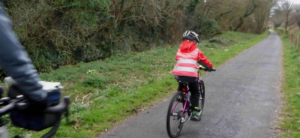Posts
A complex kind of peace

Latest posts

Could Girls on Bikes replace GDP?

Transforming Youth Employment with Systems Change in Africa

System Change in Action: The Wigan Deal
Share:
It’s been 25 years since the Good Friday Peace Agreement was signed and brought an almost end to the violence in Northern Ireland. What have we learnt from The Peace Process? How ready and willing are we to let go of being right and accept the truth of vastly different perspectives?
Share:
The cost-of-living crisis: building more collective responses

Latest posts

Could Girls on Bikes replace GDP?

Transforming Youth Employment with Systems Change in Africa

System Change in Action: The Wigan Deal
Share:
The UK cost-of-living crisis is a complex problem.
- It has multiple root causes (inflation, the war in Ukraine, fuel prices, long-term economic trends and more).
- It is dynamic so it is changing and shifting as we work on it.
- No single institution can solve it alone (however powerful well intentioned or well-resourced they are). It is a problem that will only give in to collective action.
- And finally, some of the reasons it is so hard to shift is that there are trade-offs. Putting up wages puts pressure on inflation (and raises costs). Higher taxes have both political and economic implications, likewise with greater subsidies for things like energy costs.
For these reasons, there are no simple answers to the cost-of living crisis; no silver bullet solutions to reach for.
So, what do we do next?
In moments like this, when faced with problems with a high degree of complexity and uncertainty about ‘who should do what’, we need to stop calling for other people to ‘do something’ and start building better collective responses.
Complex problems by their nature need collective actions. We need actions that vary by context – that are adapted for different social groups, regions and the different ways that the cost-of-living crisis is driven and experienced.
Wasafiri has been supporting a range of organisations and clients with their work to build more collective responses to the Cost-of-Living Crisis:
- The Forward Institute has convened leaders from across some of the UK’s leading public, private and not-for-profit organisations. And together they are sharing ideas, collaborating and getting practical with their response.
- Brighton & Hove City Council convened a summit (facilitated by Wasafiri) that brought key partners together to align and coordinate support, share information and identify ideas and actions to strengthen a collective response. The large turnout demonstrated the high levels of motivation to work more collectively across the city.
Across this work we are noticing a few trends:
- The cost-of-living crisis cannot be solved at the individual level – food banks, personal finance advice, low-interest loans for travel passes, and even home insulation are all things that will help people to live in the current context but won’t change the context. They are useful and important, but they are a response to the presenting problem – not an attempt to shift its causes.
- Local collective action – the specific drivers and experiences of the cost-of-living crisis vary by geographic region but also industry, demographics, and a whole host of other variables. Consequently, responses need to be equally varied.
For example, in Cumbria, a rural area in the north of England, there is a lot of available employment but the cost of transport is a significant barrier to people accessing it. The current (government-funded) experiment to cap bus prices at a flat £2 has more than halved the cost of bus transport in the region and opened up employment opportunities.
For an even more innovative (and artistic) attempt to take a collective response check out Power, a project to get a street in London to become its own green power station. The Power project is a recognition that the incentives for individuals to invest in things like solar panels just don’t stack up. On top of this there are significant barriers for individuals including finding suppliers, dealing with planning permissions, having the upfront cash to invest. By taking a collective approach the logistics and the financial incentives are shifted and a sense of belonging and community is created.
Let’s look to the long term
The cost-of-living crisis is a symptom of an underlying system driven (in part) by a dependency on carbon-based energy. We know that we need to change this.
As the cost-of-living crisis stimulates us to change the way we do things – like how we build our homes, use transport, the food we eat, the energy we consume, the products we reuse (or never use) – let’s make these changes not just to get us through this storm but to help us adapt and move towards a more sustainable and even regenerative future.
Join our community of system change leaders.
To learn more about Systemcraft, our approach to complex change, and how to use it in your work – sign up for our online course.
Photo by Sarah Agnew on Unsplash
Share:
Organisational silos are working (and they can work even better)

Latest posts

Could Girls on Bikes replace GDP?

Transforming Youth Employment with Systems Change in Africa

System Change in Action: The Wigan Deal
Share:
Systems thinking shows us that ‘the system is working’. Silos in organisations are a case in point. The challenge with silos then is not to break them. Rather, we must ask how we better connect them.
Recently, whilst recruiting for a senior leader, I read a CV of a man who declared his leadership superpower was ‘breaking down silos’. But what if the silos are helping? What if we like silos? What if the silos don’t need breaking but nurturing?
In the world of organisations, it can seem that there is no crime more egregious than creating, working in, and let alone liking silos. And yet, in pretty much every organisation too big to fit around a kitchen table, there are sub-teams or silos. You too are probably part of one.
One of the universal truths of systems thinking is ‘if it exists it is working’. We keep on inventing silos in our organisations despite their lack of popularity. The question then is ‘for whom and in what way are silos working’?
Silos let us know who we belong to – who our people are – who does work like us – who understands the challenges we wrestle with – who knows the things that can help us. And silos create tight accountability.
Structurally, they allow organisations to chunk down accountability beyond the overall organisation performance. Silos mean we can see if the engineering department is developing products with suitable quality, we can see if the sales department is getting out into the market and generating interest, and we can measure if the customer service department is responding well to customers.
And in big organisations – be they public or private – silos help us to see and organise the parts or the organisation and not just the ‘whole’.
System thinking teaches us that resistance to change always sits in what is working and not in what isn’t working. And so, it is all this ‘useful stuff’ that makes silos so resilient to the best efforts of the most evangelical of mangers.
We have seen this in our work with the National Health Service in the UK. Again and again, we see how the silo between ‘hospital’ (clinical) care and social care (at-home nursing) can increase costs and impact negatively on patient health.
This is an organisation full of committed patient-centric people but the structures that define how funding flows and work is organised repeatedly lead to people being stuck in hospital for longer than they want and need, costing more money than they should and often getting less healthy.
In some organisations, the negative impact of silos goes beyond unintentional outcomes and silos become the borders around which an organisation wages civil warfare on itself. Silo leaders seek to capture resources, battle for talent, stake out their territory, and advocate for ‘their’ people. All this effort distracts from whatever the organisation exists to do and pulls at the very seams that hold it together.
So, if silos are both a good and useful thing as well as a bad and unhelpful thing, what do we do next? And how can systems thinking help us?
System thinking reminds us that our work is not to work primarily on the elements (bits) that make up a system, rather it is to work on the connections between them. So, in this case, we need to look not at how we break down or replace silos (matrix management anyone?) but at how we connect them better to each other. This is the power of networks.
Imagine you are part of a sports team. Perhaps you love to play football (or hockey, canoe polo, or kabaddi). That team you are part of is a silo – it connects a set of people in a discreet bounded way. But if you are part of, say, a football team, to really do the thing you exist to do, you need to play (work) with other teams. So, you join a league.
Now you need to connect with other teams, you need to share a calendar, you need to share resources, and have agreements about who plays who when and where, you need shared rules and norms and ways of collecting data.
You become part of a great team and a great league not because you win all the time but when the games you play are closely matched, when each team elevates the performance of the other, when the play itself is a joy to watch and be a part of. When this happens the league as a whole produces something that no team can produce on its own – great games of football/hockey/canoe polo/kabbadi.
In the organisational context, we don’t want competitions between our teams (silos) in the same way that sports teams do – but we do want them to connect closely, to bring out the very best in one another, to create between them something that no individual silo can do on its own.
We need our specialist teams to maintain their own sense of belonging, to know what they are accountable for, to invest in their distinct area of focus but to know that their ultimate success depends on their ability to connect with other silos. Creating this connected network is the work of the system leader.
So next time you find yourself bemoaning the silos within your organisation – ask yourself not what you can do to break them but rather what you can do to better connect them.
To learn more about how you can use an applied systems-based approach in your work, join the Systemcraft community and take the Systemcraft Essentials course.
Share:
Dying with dignity: time for palliative care for corporations?

Latest posts

Could Girls on Bikes replace GDP?

Transforming Youth Employment with Systems Change in Africa

System Change in Action: The Wigan Deal
Share:
Organisations do die; palliative care could reduce the destructive and increase the creative impact of their passing
I was recently working on a Forward Institute event with the rather brilliant Scott Morrison of The Boom!1 He asked the audience “what are the most heretical questions you could ask about your organisation?, This question has sent me off on all sorts of mental meanders and what-ifs. The latest being: Should our organisations really strive to live forever? Could it be a good thing for organisations to die off at some point?”
Much of management and organisational development is centred on the assumption that longevity is a good thing. That being able to reinvent, restructure and pivot are the practices we need. That endless regeneration and never-ending existence are the ultimate goals. That survival is the ultimate performance measure2. But is it? Everything in nature ages and ultimately dies with new growth flourishing in the space created. In reality, organisations will have their time in the sun and then pass on (with increasingly few passing the 60-year mark) and some suggesting as little as 18 years is a reasonable life expectancy3 yet the myth of immortality is a strong one. A myth that often seems to lead to painful deaths, heralded by increasingly bellicose claims of reinvention, promises of new dawns and possibilities and ending with dramatic and painful collapses.
Others have argued in favour of the value of corporate death. Joseph Schumpter is perhaps the most famous with his idea of ‘creative destruction’ and the argument that large companies are inherently inefficient, and ultimately suffer from ‘entropy’ where they spend more time managing themselves than doing whatever it is they are supposed to do in the world. But there is a long distance between what is good in principle and what is good in practice. Schumpter’s principle of ‘creative destruction’ often in practice means the destruction of people’s lives and livelihoods, and, especially when an organisation has a strong geographical footprint, their communities. But what if responsible leadership included knowing when your organisation’s time was up? What if with good palliative care organisational demise need not be ‘destructive’? Maybe palliative care could create a graceful decline and provide individuals and communities with the opportunity to move on in timely, happy, and healthy ways?
What might organisational palliative care look like?
Step one: Timely diagnosis
By acknowledging that the organisation has reached its twilight years we can all prepare for a transition. Customers have time to find alternative options with less risk of price gouging by unscrupulous competitors. Suppliers have time to diversify and employees can think about what new skills they might need and take the time to find new opportunities. Local markets won’t be flooded with a sudden unemployed workforce all competing with one another.
Step two: Managed decline
Our organisational models are built for growth – we know how to add and do more – but how about doing less? Perhaps staff move from full to part time employment or the entire organisation shifts to a 4-day workweek. There will undoubtably be plenty of puzzles to manage as we simply haven’t built organisations that are alive but slowing down; we will need markets not scared of big players that are doing a good job but reducing rather than expanding their activities. Customers need to value the old-age organisational citizens in their world and not just the young and new. There needs to be confidence in the provision of ongoing support for products whose life cycle may be longer than that of their producer.
Step three: Make good choices about divesting assets
Are there buildings, machines, or existing inventory to be sold off? The current mode of sudden collapse makes these sorts of assets easy prey for post-bankruptcy acquisition often allowing asset stripping by predatory interests. But what if these assets could be moved on with care and consideration – perhaps with the money raised forming an inheritance for the employees or communities that will be affected by their passing?
Step four: Celebrate the passing
I remember the passing of the British high-street staple Woolworths4; a final splutter of press attention and then a quick burn out… and with it a load of pain for the 30,000 people that worked there. I also remember the aftermath; the flurry of joy at shared memories of ‘the Woolworths bargain bin’- a place many of my generation bought their first music albums (Tears for Fears for me). At the time I hadn’t been in a Woolworths store for many years, but its passing brought back a nostalgic memory of happy time and ritual. Maybe palliative care would include a celebration of past success rather than glorifying in the moments of collapse?
The reality is most private sector organisations do, eventually, age and decline. And perhaps this is not such a bad thing. Perhaps we just haven’t yet learned how to responsibly help them age with grace and pass with as little pain as possible for the people that depend on them. All living systems include death as well as birth; as we face the climate crisis and the need to reimagine our economies, our modes of energy production and much else besides perhaps ‘organisational palliative care’ can help us create the new world we need?
Wasafiri currently works with the Forward Institute, a not for profit that works with many of the UK’s leading public, private and charitable organisations to make ‘responsible leadership the only form of leadership’. Through the use of Systemcraft we help leaders tackle the complex problems they and their organisations are wrestling with as they play their part in creating a more sustainable and equitable world.
Written with thanks to Adrian Brown, Executive Director of the Centre for Public Impact for the, as always, help to think about things a little differently.
- https://www.unleashtheboom.com/
- Mckinsey Report 2014 https://www.imd.org/research-knowledge/articles/why-you-will-probably-live-longer-than-most-big-companies/
- https://www.imperial.ac.uk/business-school/blogs/executive-education/why-companies-die/
- Woolworths was a low-cost department store in the UK, not related to the South African brand, that went bankrupt in 2008 https://en.wikipedia.org/wiki/Woolworths_Group_(United_Kingdom)
Share:
In this blog we hear from Wasafiri’s Head of Operations, Scott Hinkle, who has been on the forefront in helping Wasafiri navigate the turbulence of Covid-19.
PHONE
+44 (0)1273 830335
+254 (0)797 519466
+1 828 407 6585




